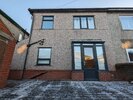Recently moved in to a 1920s typical 3 bed semi that has had the kitchen extended (over 20 years ago) & the wall between the kitchen & diner has been knocked down (4-5 years ago) to create an open plan kitchen diner. Talking roughly 5m x 7.5m altogether.
There is one vertical radiator for the space & a gas inset fire in the chimney breast. I am convinced that the single panel vertical radiator is significantly undersized (1500w MAX at a guess) which is why the room sits at 11-13'c every morning even after the heating has been on for > 1 hour. It is never hot to touch & both myself & a plumber have tried to balance it with the conclusion being that it is undersized. Probably does an ok job at heating the ceiling though...
The gas fireplace costs a lot to run in comparison to the central heating so running it every day isn't really a solution. The rest of the house heats up slowly but fine (whacking my flow temp to 75-80 helps), I attribute this to the high ceilings & old imperial radiators without fins. I suspect that if I could improve temps in this huge chunk of the downstairs that it'd help the rest of the house retain heat better overall.
I have a small 2kw electric heater which can roughly being the temps of the room to 18-19'c after 45mins-1hour (longer in these minus temps). The issue is that the heat loss then happens at roughly 2-2.5'c a minute which is very fast in comparison to the rest of the house where it's max 1'c a minute. Plus electric obviously costs more.
I borrowed a thermal imaging camera and it is clear to see that a main contributor to the injury is the attached external wall where the patio doors are as attached in the images.
Both sides of the internal (ORIGINAL) wall (cavity insulated) & the plasterboard (NEW work pictured under the french doors that meant this area of the original wall was destroyed to create it) under the french doors/windows have paint peeling & I believe it's because the bricks outside had barely any mortar in them. After getting them pointed their temperatures have improved, humidity is also improved (used to struggle to get below 60% now I can get 45%) so I hope that they are hopefully on the mend damp wise. There are raised ground levels outside above the DPC (assuming the DPC is actually still intact...) due to garden decking from the previous owner which I should remove & may have led to this penetrating damp problem from rain.
HOWEVER there are two plasterboard walls as attached in the images (note: I have had the cavity wall insulation checked and it's the wool) either side of the patio door which sound hollow & always record 8'c-10'c. When I put the electric heater on, the ground the temperature in the room increases at 3x the speed than when placed on the kitchen top. I believe when the heater is on the ground it's counteracting that particular injury.
I am unsure if my problem here is damp (I have spots where I get 17-22% readings with a pin damp meter - main ones actually being close to the electric sockets either side - surveyor told me before purchasing that there was damp in that area but that removing the raised ground levels i.e. decking outside + ventilation + pointing so rain can't get in, would get rid of it over time - no high damp readings higher up) or whether the previous owner did this work by dotting & dabbing uninsulated plasterboard to the external brick wall.
How can I address this problem? Obviously I'm exploring upsizing the radiator & seeing the feasibility of running new pipes for a second radiator (LVT makes it a big job). But I don't see the point in upsizing the radiator if the heat just escapes! Or maybe if it's damp, on the contrary I need heat to dry things out?
I'm really confused as to what the root cause of the issue is. It can't be healthy to keep this area un-heatable like this & it's such a shame particularly considering energy prices.
Thanks
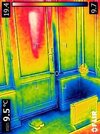
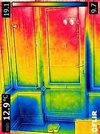
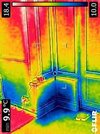

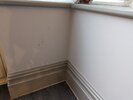
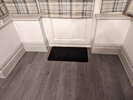
There is one vertical radiator for the space & a gas inset fire in the chimney breast. I am convinced that the single panel vertical radiator is significantly undersized (1500w MAX at a guess) which is why the room sits at 11-13'c every morning even after the heating has been on for > 1 hour. It is never hot to touch & both myself & a plumber have tried to balance it with the conclusion being that it is undersized. Probably does an ok job at heating the ceiling though...
The gas fireplace costs a lot to run in comparison to the central heating so running it every day isn't really a solution. The rest of the house heats up slowly but fine (whacking my flow temp to 75-80 helps), I attribute this to the high ceilings & old imperial radiators without fins. I suspect that if I could improve temps in this huge chunk of the downstairs that it'd help the rest of the house retain heat better overall.
I have a small 2kw electric heater which can roughly being the temps of the room to 18-19'c after 45mins-1hour (longer in these minus temps). The issue is that the heat loss then happens at roughly 2-2.5'c a minute which is very fast in comparison to the rest of the house where it's max 1'c a minute. Plus electric obviously costs more.
I borrowed a thermal imaging camera and it is clear to see that a main contributor to the injury is the attached external wall where the patio doors are as attached in the images.
Both sides of the internal (ORIGINAL) wall (cavity insulated) & the plasterboard (NEW work pictured under the french doors that meant this area of the original wall was destroyed to create it) under the french doors/windows have paint peeling & I believe it's because the bricks outside had barely any mortar in them. After getting them pointed their temperatures have improved, humidity is also improved (used to struggle to get below 60% now I can get 45%) so I hope that they are hopefully on the mend damp wise. There are raised ground levels outside above the DPC (assuming the DPC is actually still intact...) due to garden decking from the previous owner which I should remove & may have led to this penetrating damp problem from rain.
HOWEVER there are two plasterboard walls as attached in the images (note: I have had the cavity wall insulation checked and it's the wool) either side of the patio door which sound hollow & always record 8'c-10'c. When I put the electric heater on, the ground the temperature in the room increases at 3x the speed than when placed on the kitchen top. I believe when the heater is on the ground it's counteracting that particular injury.
I am unsure if my problem here is damp (I have spots where I get 17-22% readings with a pin damp meter - main ones actually being close to the electric sockets either side - surveyor told me before purchasing that there was damp in that area but that removing the raised ground levels i.e. decking outside + ventilation + pointing so rain can't get in, would get rid of it over time - no high damp readings higher up) or whether the previous owner did this work by dotting & dabbing uninsulated plasterboard to the external brick wall.
How can I address this problem? Obviously I'm exploring upsizing the radiator & seeing the feasibility of running new pipes for a second radiator (LVT makes it a big job). But I don't see the point in upsizing the radiator if the heat just escapes! Or maybe if it's damp, on the contrary I need heat to dry things out?
I'm really confused as to what the root cause of the issue is. It can't be healthy to keep this area un-heatable like this & it's such a shame particularly considering energy prices.
Thanks








